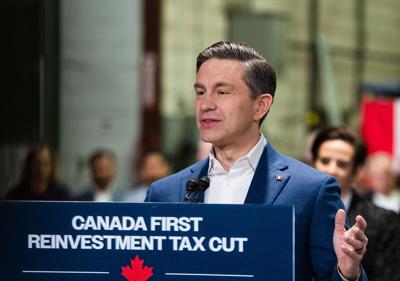Race tightening between Mark Carney’s Liberals and Pierre Poilievre’s Conservatives, polls suggest
The Star’s election predictor, the Signal, says the Liberals’ advantage has narrowed but the governing party could still win a majority in the April 28 federal election.
Updated 2 hrs ago
March 31, 2025
2 min read
Save

Conservative Leader Pierre Poilievre holds a campaign event at Petro Plastics Corporation Ltd. in Toronto on March 30, 2025.
Pierre Poilievre’s Conservatives are starting to cut into Mark Carney’s Liberals’ lead, polls suggest.
The Star’s election predictor, the Signal, says the Liberals’ advantage has narrowed but the governing party could still win a majority in the April 28 federal election.
“You continue to see that volatility here, where the ebb and flow of the Liberal vote really varies more than the Conservative trend line,” said Clifton van der Linden, a McMaster University political science professor and the CEO of Vox Pop Labs, the independent research organization that developed the Signal.
New cabinet working 'full steam' ahead of election: Minister Anandasangaree
On Monday, the Signal had Carney’s Liberals at 41.5 per cent public support and forecast to win 179 seats in the 343-member House of Commons.
That compared to 40.5 per cent and 143 seats for Poilievre’s Conservatives.
Jagmeet Singh’s New Democrats were at eight per cent and seven seats while Yves-François Blanchet’s Bloc Québécois was at 5.4 per cent and 14 seats and the Greens with co-leaders Elizabeth May and Jonathan Pedneault were at 1.7 per cent and no seats.
The Signal is an online tool that aggregates publicly available polling information from across Canada and crunches the data in a supercomputer that runs thousands of simulations daily.
“So much of this race is tied up in the perception as to whether the Liberals under Mark Carney or the Conservatives under Pierre Poilievre will be better positioned to negotiate with Donald Trump,” said van der Linden, pointing to Carney’s cordial call with the U.S. president on Friday.
But Trump’s tariffs on Canadian goods that are set to take effect Wednesday and retaliatory countermeasures from Ottawa could further jolt the race.
“If people perceive an immediate impact (of tariffs) in their day-to-day life, then that could change things,” the professor said, noting prices could rise at grocery stores and workers could be laid off if factories are shuttered due to supply chain problems.
“Right now, I think people are just holding their breaths,” he said.
According to the Signal, the Liberals would take 79 of Ontario’s 122 seats with the Tories winning 41 and the New Democrats two.
But the aggregator does not include internal polling shared with the Star by Premier Doug Ford’s provincial Progressive Conservatives that paints a dire picture for the federal Tories in Canada’s most populous province.
“That’s because of the difficulty of incorporating single region polls,” said van der Linden.
The provincial Campaign Research survey had the Liberals at 48 per cent, the Tories at 33 per cent, the NDP at 11 per cent and the Greens at four per cent.
That 15 percentage point lead for the Liberals over the Conservatives in Ontario compared to the Signal’s 4.7 percentage point advantage for the Grits here — 46.7 per cent to 42 per cent.
Campaign Research surveyed 1,902 Ontarians between March 24 and 26 using the Maru/Blue online panel. While opt-in polls cannot be assigned a margin of error, for comparison purposes, a random sample of this size would have one of plus or minus 2.2 percentage points, 19 times out of 20.
In Quebec, the Signal suggests the Grits would gain 50 of that province’s 78 seats to 14 for the BQ, 13 for the Tories and one for the NDP.
“Quebec continues to be a bulwark for the Liberal vote share. It’s quite incredible,” said van der Linden.
“The gains come almost completely at the expense of the Bloc Québécois.”
For context, on Jan. 1, the week before Justin Trudeau announced his resignation as Liberal leader, the Signal had the Tories at 46.9 per cent, the NDP at 18.7 per cent, the Grits at 18.6 per cent, the BQ at 9.7 per cent and the Greens at 2.7 per cent.
At dissolution, the Liberals, who have been in office since 2015, had 152 seats, the Tories 120, the Bloc 33, the NDP 24 and the Greens two. There were three Independents and four vacancies in the 338-seat Commons, which is being expanded by five ridings due to population increases. |





